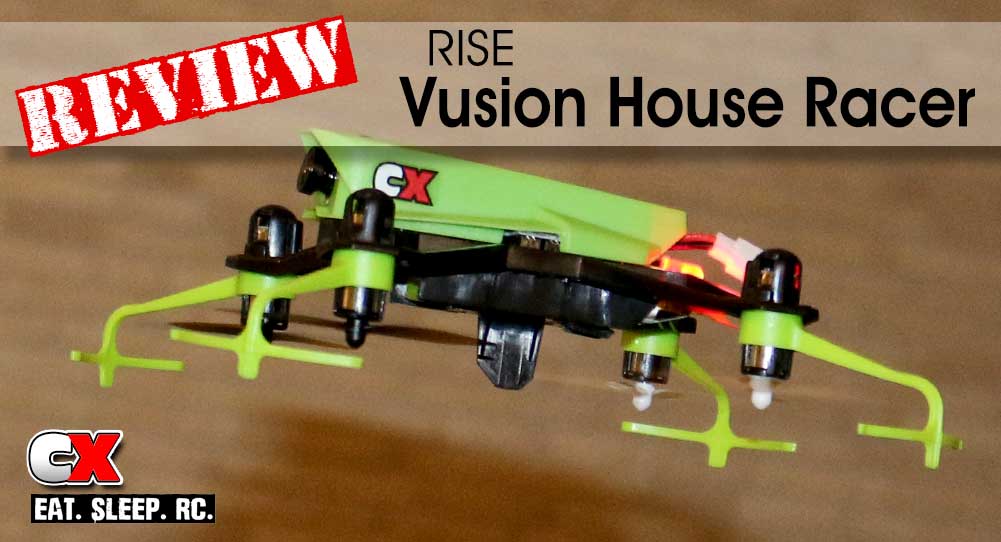
Zippy Indoor FPV Racer
For some parts of the country, winter season is indoor season, especially for surface RC. The same can be said for aerial RC unless, of course, you don’t mind possibly getting your drone wet from landing in the snow. Thankfully, being in SoCal has it’s advantages, allowing outside fun almost year-round, so there’s plenty of time to fly Drones. Occasionally, though, there is a spritz of rain here and there that can cause a delay in the fun – sort of like this year. We’ve had more rain so far this year than I can remember in the past 3 or 4 years. It seems like every other day we’re getting pounded, making it impossible to fly. On top of that, the park across the street from my house has become a swamp … muddy shoes do not make the wife happy.
I was pretty stoked when RISE / Hobbico contacted me about giving their new House Racer a go. It’s designed for times like this when it’s too cold or rainy out to play but you just have to get your Drone on. Sounds good to me; I mean really, who doesn’t want to buzz around the house while sitting in their underwear! I’m in – let’s check out the House Racer and see what it’s got going on!
Product: RISE Vusion House Racer FPV Drone, RISE Vusion House Racer Indoor FPV Race Pack
Part Number: RISE0208 (Drone only), RISE0207 (Indoor FPV Race Pack)
Type: FPV Indoor Drone
Price: $79.99 (Drone only), $179.99 (Indoor FPV Race Pack)
Recommended For: FPV enthusiasts wanting (or needing) to take their hobby indoors
Features
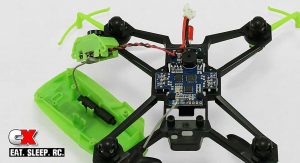 Chassis
Chassis
The House Racer comes fully assembled right out of the box. It features four durable, dual-legged C-channel arms that are molded right to the chassis. The flight board is attached to the top of the chassis with the motor wiring routed up in the channels of the arms. The battery mounts into a tray underneath the House Racer and flexible legs attached to the motor area act as cushioned landing feet. There’s also a small tab protruding from the bottom of the Drone, almost like a tab for hand launching. I might have to give it a try.
A high-visibility, green canopy is mounted to the top of the chassis. It protects all the innards and houses the FPV camera and signal antennas (for the FPV and radio). A bright red LED shines out the back; combined with the glowing canopy, the House Racer is easy to see even in low-light conditions (for you LoS fliers).
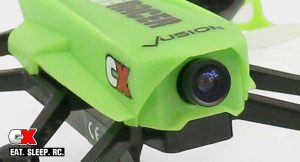 Camera
Camera
Poking through the front of the bodywork is the 600TVL resolution FPV camera. Unlike it’s larger cousin (the Vusion 250), the House Racer’s camera transmits it’s 640x480p VGA video back to your FPV monitor (there’s no record on the Drone itself). The unfortunate part is that, in this format, the video is compressed prior to it displaying on the monitor. This can cause a little fuzziness at times but, as you can see, it’s still a good picture. Like the Vusion 250, the video does get recorded in AVI format for easy playback.
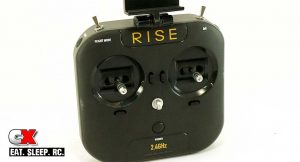 Transmitter
Transmitter
The House Racer comes in two flavors; Vusion House Racer Race Pack and Vusion House Racer FPV Race Pack. Since I already had the Vusion 250 Race Pack (containing the transmitter, goggles and monitor), I opted for the FPV-Ready version. The J2000 transmitter is a 6-channel unit that works on 2.4GHz and has features like Dual-Rate, video and picture buttons, Flight-Mode switch and, of course, all the appropriate trims. It also has a monitor holder attached to the top for those that like to fly FPV as well as being able to keep an eye on their surroundings. The J2000 has a great comfortable feel, much better than other entry-level transmitters.
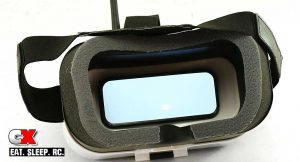 Goggles
Goggles
Like the transmitter, I used the goggles from my Vusion 250 as well. They may seem bulky, but they need to be able to accept the 4.3″ monitor included with the Race Pack. Monitor installation is a cinch; open the flap, drop the monitor in, close the flap and slide the locking switch in place.
The goggles come with adjustable straps to cater to different size heads – thank goodness. My dome is a little bigger than most but the straps made it easy to adjust. Once on, they’ll seem a bit weighty but tilting your head down a little helps quite a bit.
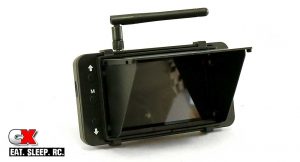 Monitor
Monitor
The monitor (once again used from my Vusion 250), features a 4.3″ color LCD screen with a resolution of 480×272. It uses the 5.8GHz frequency to gather the video and works on 5 bands (A, B, E, F, and R) as well as 40 different channels. There are numerous buttons around the face; Up/Down selection, a Main Menu button, Channel Select, Band Select and DVR Start/Stop. Located on the right side of the unit are the power button and charge jack. If you get the House Racer Race Pack, you’ll notice there is no charger included for the monitor. Ya, bummer, but the correct cord is only a couple bucks so it’s not a deal breaker.
When turned on, the monitor has several icons displayed on-screen; those include Total Time, FPV Band, FPV Channel, FPV Frequency and Battery Charge. There are also two additional icons; Memory Card (if installed) and Video Clip Timer (when you’re recording video).
Pressing the Main Menu button allows you to customize some of the monitor settings like Brightness, Contrast, Color, Language and the Backlight. There’s also a feature to reset the monitor’s settings to factory specs.
For those of you that like to fly LoS, the monitor comes with a foldable sun shade to aid in seeing the screen. If you’d prefer to drop the monitor in the goggles, simply remove the sun screen – pretty easy.
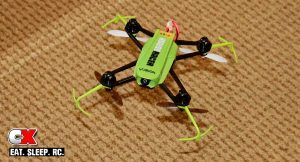 Flight Modes
Flight Modes
The Vusion lineup of Drones features multiple flight modes depending on your skill level.
Flight Mode 1 is where you should start during the first flight with your House Racer. This mode engages the Stability feature, making it very easy to fly. Mode 1 also limits the Tilt Angle to 30° and sets the Roll Rates to Low. This is the most stable setting and will provide the best video.
Flight Mode 2 kicks it up a notch. The Stability feature is still engaged, however the Tilt Angle is boosted to 45° and the Roll Rates are bumped up to Medium. This is geared to a more advanced pilot that has good Drone control.
Flight Mode 3 – damn. In this mode, Stability is turned off, Tilt Angle set at 360° and the Roll Rates are on high. Here is where you can show off some flips and other crazy maneuvers but, unless you’ve got some serious skill, expect to crash alot in this mode.
Complete FPV Package
While this review revolves around the House Racer as a single unit, it is also available in the FPV Race Pack version as well. The Race Pack includes everything mentioned in this article; the House Racer, the J2000 6-channel transmitter, goggles, monitor, spare props, a battery and a charger. It’s a fantastic kit that is geared towards beginning FPVers, all for $180. That’s a great deal if you ask me!
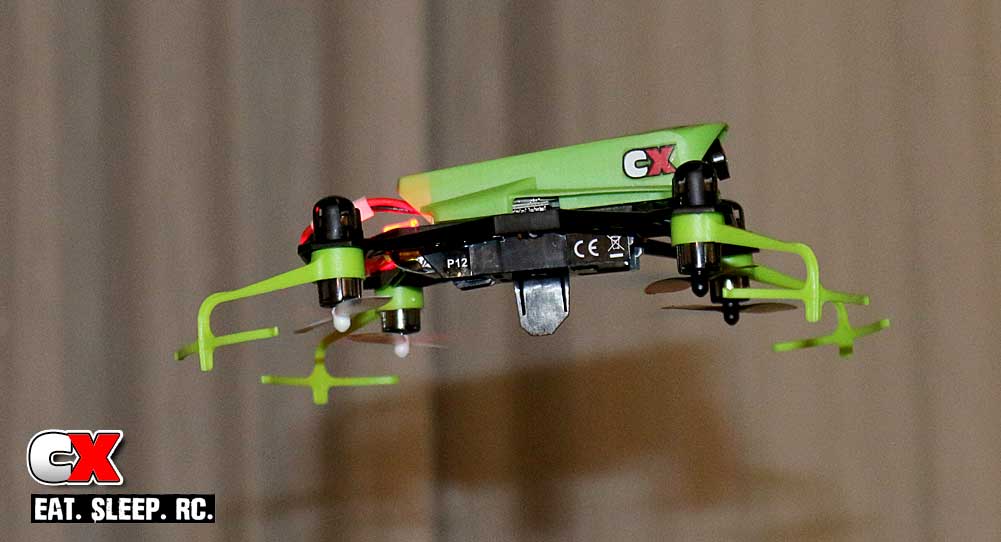
Flight Time
As I mentioned earlier, SoCal has been getting more than it’s fair share of falling water. This has cut down the outdoor fun I’ve been having with my RISE Vusion 250 Racer; but thankfully the House Racer is here to save the day.
Before we get to the flight, I made sure to plug the battery into the included USB charger and inserted it into my computer. I have several different types of USB charging outlets but found the computer (or my Reedy 1216-C2 Charger) to give the best consistent charge. When the light on the USB charger goes solid, you’re ready to rock and roll.
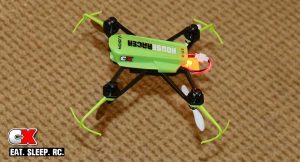 Since the House Racer is a RISE product, binding it to my J2000 radio is extremely easy; plug the battery in on the House Racer, set it on a flat surface and press the power button on the transmitter – within seconds it automatically finds the signal and binds itself. Before throttling up, though, I suggest calibrating the Drone. This is a simple process that requires the trims to be centered following by holding the flight sticks to the lower right corners. The manual states this is only needed before the first flight but since I’m switching back and forth between my Vusion 250 and House Racer, it’s probably necessary to reset the trims each time.
Since the House Racer is a RISE product, binding it to my J2000 radio is extremely easy; plug the battery in on the House Racer, set it on a flat surface and press the power button on the transmitter – within seconds it automatically finds the signal and binds itself. Before throttling up, though, I suggest calibrating the Drone. This is a simple process that requires the trims to be centered following by holding the flight sticks to the lower right corners. The manual states this is only needed before the first flight but since I’m switching back and forth between my Vusion 250 and House Racer, it’s probably necessary to reset the trims each time.
I feel I’m a pretty good LoS pilot to this point; I can take off and land smoothly, perform large banking turns in every direction and buzz inches off the ground – all without hitting anything. This is, of course, in a large park with only a few scattered trees, so as long as I keep it airborne and away from everything I’m certainly ahead of the game. To get a good feel for the House Racer, I initially took it out front and cruised around a bit. Moving indoors, however, is a bit of a different story.
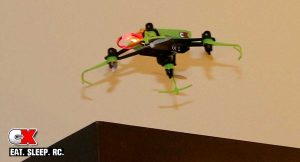 First off, the House Racer is pretty quick and, unless you live in a large, very open-concept house, you’ll definitely have some issues getting it up to full speed. The wife and I went on a weekend getaway and, since I knew we’d be staying in a pretty spacious room, I brought the House Racer with me (yes, she knew ahead of time). There was a short hallway that led into the somewhat large room with an opening that circled through the bathroom, over a jacuzzi tub, past the enclosed shower and back to the short hallway. It was fun but a bit tight, resulting in more of a putt-putt session to avoid hitting anything. The camera works well and the transmitted video looks good, but the quality isn’t quite as good as the onboard recorded right from my Vusion 250. This is a result of the video compression; it’s sort of like watching an HD movie, then watching it again in standard definition. It still looks good, just not as crisp and sharp.
First off, the House Racer is pretty quick and, unless you live in a large, very open-concept house, you’ll definitely have some issues getting it up to full speed. The wife and I went on a weekend getaway and, since I knew we’d be staying in a pretty spacious room, I brought the House Racer with me (yes, she knew ahead of time). There was a short hallway that led into the somewhat large room with an opening that circled through the bathroom, over a jacuzzi tub, past the enclosed shower and back to the short hallway. It was fun but a bit tight, resulting in more of a putt-putt session to avoid hitting anything. The camera works well and the transmitted video looks good, but the quality isn’t quite as good as the onboard recorded right from my Vusion 250. This is a result of the video compression; it’s sort of like watching an HD movie, then watching it again in standard definition. It still looks good, just not as crisp and sharp.
The camera has a very wide-angle perspective. This was a little misleading at first as to how close objects are, but after a few minutes of flying (and banging into walls) I was able to get my bearings and get cruising around the room. But, like all racers, I wanted more speed.
To get the better representation of what the House Racer had to offer, I enlisted the skills of my buddy Josh Numan, a seasoned RC surface racer that has since added Drones to his repertoire. He’s been drone-racing alot and has become quite good, so I knew he’d be able to show what the House Racer is capable of. I handed it off and after getting it back, found that his video certainly looks alot better than mine did.
Additional
• 5-Channel radio
• 5.8GHz monitor
• Goggles
• RISE J2000 6-channel 2.4GHz transmitter
• Tactic FPV-RM2 40-channel FPV monitor
• Tactic FPV-G1 goggles
Spec Data
Diagonal Size: 4.7″ (120mm)
Height: 2.0″ (52mm)
Weight: 2.4oz (68g)
Propeller Length: 2.3″ (58mm)
Electronics
Motors: Brushed – 4; 2 CW, 2 CCW
Video Transmitter: 5.8GHz
Battery: 1S 650mAh LiPo
Flight Time: About 6 minutes
Resolution: 600TVL
Input Voltage: 3.6-5.5V
Memory Card Capacity: n/a
External Video Quality: 640x480p VGA
Internal Video Quality: n/a
Video Format: AVI
Photo Resolution: n/a
Receiver/Monitor
Monitor: 4.3″ (109mm) color LCD
5.8GHz Receiver: 5 band, 40 channels
Antenna: RP-SMA 3dBi whip
Resolution: 480×272
Format: NTSC/PAL
Memory Card Capacity: Up to 32G
Battery: 1S 3.7V 1400mAh LiPo
Runtime: 1.5 hours
• Small size for easy maneuvering
• Very durable
• Guards help protect the blades in the event of a mishap
• Easily binds to your RISE J2000 radio system
• Good flight time for it’s size
• USB charger gives great charging flexibility
• Multiple flight modes for different skill levels
• Size and speed works great outdoors as well
• A bit fast for beginning indoor droners
• USB charger was a little finicky
Conclusion
The RISE Vusion House Racer hits the mark for a fun, fast indoor Drone. Prep is simple; the USB charger allows you to charge the 650mAh pretty much anywhere quick and easy. Slide the battery in place, plug it in and push a single button on the transmitter – done – binding complete and time to start flying! Indoors, the House Racer is capable of slowing cruising around with ease, the limits being the size of your house. Find yourself some warehouse space and it’s game on – add some boxes, poles or even a few Hula-Hoops and you’ve got a great makeshift course (either LoS or FPV)! Heck, on a pretty calm day, the House Racer is also a joy to fly outside. It’s certainly a versatile flyer that will only leave you needing one thing; more batteries.
Features: 8.5
Appearance: 9.5
Performance – Speed: 10
Performance – Handling: 9.5
Video / Picture Quality: 7.5
Overall Value: 8.5
Connect
RISE, www.Explore-Rise.com
Hobbico, www.Hobbico.com
Gallery
 CompetitionX CompetitionX is the most up-to-date source for RC Car News, Reviews and Videos for Radio Control. We also have the most comprehensive Manual Database on the web.
CompetitionX CompetitionX is the most up-to-date source for RC Car News, Reviews and Videos for Radio Control. We also have the most comprehensive Manual Database on the web.





















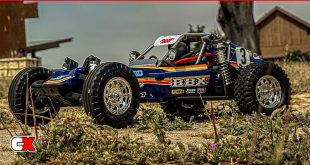
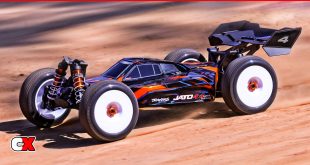
I jehave a HOVERSHOT which I found to be really easy to fly but the fpv is wifi not 5.8. I was looking for a decent fpv 5.8 drone with a good screen that really fit with the radio. I fine the Vusion House racer a good blend of what I was looking for. Your review I think was spot on. With just easy does it flying I have been getting 7 to 9 minute flight times which I consider to be pretty good for a drone of this size and weight. I can’t waite to get this little beast outside or in a gym perhaps. It is as you say pretty zippy in speed but the drone just “feels” right. I’ve flown fix wing rc aircraft for over 20 years. I’ve flown Heli’s as well but these great flying quads a blast without all the bulk of 60 to 1/4 scale fix wing aircraft. I would only and one down check, you need some space to really see what this drone can do and unless you live in a 5,000 sqft house with large open rooms. Still for the money, a very strong value.
Right! For me, it’s pretty fun in my house but I really want to open it up – that leaves me crashing into anything fixed to the ground! Like you, would love to get it into a large warehouse and blaze around. I’ve flown it outside and, on a relatively calm day, it works really well. Ready to put the RISE FPV Gate System up and get some great video of that! Thanks for the comment, Terrance.
Tony, not to sound to picky, I did discover one weakness in this drone and that is the prop guards. Right at the curve of PG in a weak point. They show signs of this. I strengthen mine by applying just a couple of drops of supper glue on Both sides at the apex of the curve. I think this is a very comman problem as I went to order a couple extra sets and the out of stock every where I looked. I did get to fly out side with it and this drone is a RUSH to open up. I mean wow. I think Rise has a winner here and they won’t be able to keep up with demand.
Actually, to tell you the truth, I never even tried it with the prop guards! At first, I didn’t know they were hidden under the insert so did the review without them. When I did find them, I tried them and they made the House Racer feel heavy and not as responsive, so I took them back off.
Might have to add that to the review. Thanks for pointing that out!